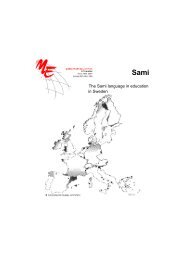Multilingual Early Language Transmission (MELT) - Mercator ...
Multilingual Early Language Transmission (MELT) - Mercator ...
Multilingual Early Language Transmission (MELT) - Mercator ...
Create successful ePaper yourself
Turn your PDF publications into a flip-book with our unique Google optimized e-Paper software.
Children need to have language input in a variety of situations from people that matters to<br />
them, there has to be a “linguistic soundscape” (De Houwer, 2009: 97).<br />
Grosjean (2010) calls it “amount of input.” Apart from amount of input he distinguishes<br />
other “factors” leading to language acquisition and maintenance and “the need of<br />
language.”<br />
Figure 3.3 Factors leading to the acquisition and maintance of another language in children. (Grosjean, 2010:<br />
172).<br />
The first factor that plays a role in the level of bilingual development is “amount of input”:<br />
children need to receive a varied and differentiated language input.<br />
The second factor is “type of input”: young bilingual children use code-switching, but they<br />
have to get “monolingual” input too, as naturally as possible. Sometimes a monolingual role<br />
can be taken on by members of the extended family who do not know the other language.<br />
Written language is also very important: it is an excellent source of vocabulary and cultural<br />
information that children may not have in their normal environment (De Houwer, 2009).<br />
When the need for language disappears or is not really there and factors are missing, then<br />
the child will no longer use the language and the language will steadily be forgotten. “The<br />
role of the family” and “the role of the school and the community” are the third and fourth<br />
factor respectively. If the minority language is not support by family, school, and the<br />
community, there is a good chance that this language will lose importance and disappear<br />
from the child’s language repertoire.<br />
So far, this analysis applies to any bilingual situation with young children. However, not all<br />
bilingual situations are equal. Family settings (mother-tongue, father-tongue, the language<br />
of other family members or caretakers) and language environment settings (outside the<br />
home, for example day-care centre) are different. In settings with a minority language as<br />
mother-tongue, the majority language is also present in every aspect of the child’s life<br />
(through media/television etc.). Parents, caretakers, and teachers should be aware of<br />
processes their children are going through as they are acquiring (or losing) a language. They<br />
56



